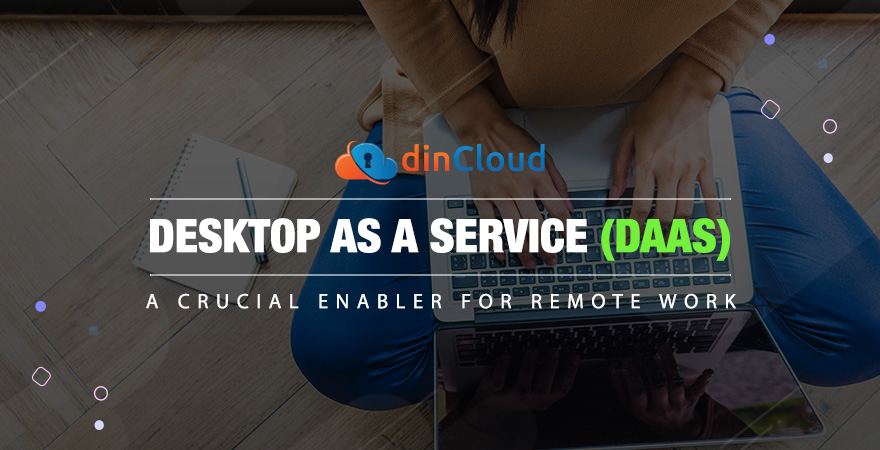We are well into the Covid-19 pandemic that has transformed concepts around productivity. In the new world that’s powered by “remote work”, the physical boundaries of organizations are disappearing.

Both employers and employees alike were completely unaware of how a prolonged work from home (WFH) scenario would look like. Based on encouraging stats over the past few months, we can infer that remote work is here to stay for good, even after Covid-19.
The prime concern for employers was regarding productivity. Most of them were skeptical of employee productivity without a structured work environment that’s mainly possible within office premises.
Also Read: Differences between Virtual Desktop Infrastructure (VDI) and Desktop as a Service (DaaS)
Many studies over the past few months have revealed either the same or enhanced productivity levels by remotely working employees. Couple that with the cost savings employers have achieved by reducing operational overheads and it’s a win for all.
From an employee’s perspective, remote work has brought many compelling advantages. The most notable among them is saving hours of commute to and from the office, that’s both costly as well as stressful.
What are the Challenges around Remote Work?
It can be safely concluded that remote work, if performed with the proper requisites, can yield benefits for both employers as well as employees. However, you need a sound and secure technology platform to execute a productive remote work environment.
Let’s highlight the two most potent remote work platforms that enable organizations to deploy virtual desktops and achieve optimal productivity.
Also Read: How Cloud Security Fares Against Cyber Threats and Vulnerabilities?
On Premise Virtual Desktop Infrastructure (VDI)
In this model, the deploying entity will provision a data center on its premises and create virtual desktops over it. These desktops can then be accessed by employees both within the organizational premises and from the safety of their homes, mostly via VPNs.
VDI is a decent remote work solution, but it has certain downsides that need to be given thorough consideration. Firstly, VDI has a huge upfront cost as the deploying entity has to procure all the hardware in house.
The other major drawback of VDI is that it necessitates sound IT prowess at the entity level. This can become a major pain point if your core business area does not relate to IT. If that is the case, you will need a dedicated team of IT professionals to manage the VDI.
Also Read: Cloud Computing Business Applications and Implementations
Desktop as a Service (DaaS) – A Sound and Cost Effective Alternative
Now, let’s move to a remote work solution that’s way better in terms of remote productivity and is also a cost efficient alternative to VDI. This technology for deploying virtual desktops is called Desktop as a Service or DaaS.
In case of DaaS, you will provision virtual desktops that are hosted over third party data centers of Cloud Service Providers (CSP) like dinCloud. There are many factors that give DaaS a remarkable edge over VDI, while saving costs at the same time.
Also Read: dinCloud a Leading Service Provider in the DaaS Market for 2020
Instant Scalability
A DaaS solution such as dinCloud Hosted Virtual Desktops (dinHVD) provide your organization with instant scalability. You can quickly onboard new remote workers by spinning up new virtual desktops and assigning them to the relevant employees.
You can enjoy the same level of ease when you may be scaling down operations due to seasonality or contingencies such as the Covid-19 pandemic. All you have to do is de provision dinHVDs for the number of remote workers no more required for now.
In this way, you will ensure optimal utilization of resources with DaaS. In case of VDI on the other hand, you often need to ramp up additional hardware resources to scale up. When scaling down, you have no option but to hold on to the hardware you’ve already bought.
Also Read: DaaS: Giving Businesses the Freedom to Choose
Processing Intensive Workloads
dinHVDs are a very good option if you want to execute processing intensive workloads remotely. dinCloud offers a wide array of Hosted Virtual Desktops and some of our dinHVDs come along with very powerful GPUs and CPUs, purpose built for heavy workloads.
Holistic Approach to Security
In case of a quality DaaS solution like dinHVDs, cyber security is not your worry. Your data hosted over dinCloud’s data centers is not only secure, but it also meets some of the best international compliance standards for data security and privacy.
Also Read: Covid-19 Pandemic Proves a Catalyst for Growth in DaaS
To secure your DaaS solution, dinCloud adopts a holistic approach to cyber security that extends beyond our cloud infrastructure to the endpoint devices of your employees which they are using to access the assigned Virtual Desktops.
Conclusion
It can be safely concluded that DaaS is a very potent platform to power your remote workforce. DaaS is not only secure and robust, it is also a very cost effective solution for remote work over the long term.
You are welcome to Contact Us for any questions or clarifications you may have about dinCloud’s best in class Hosted Virtual Desktops or DaaS offerings.


